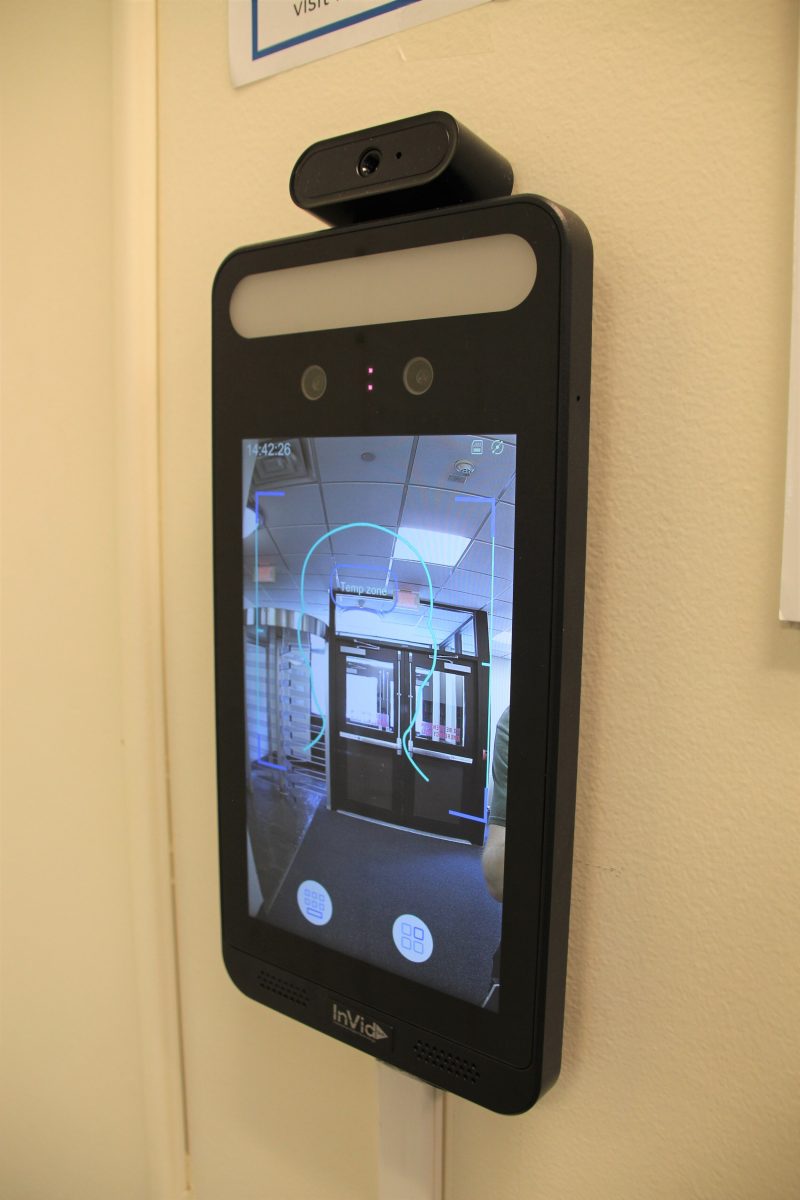Hofstra recently installed temperature check kiosks all around campus to screen for coronavirus symptoms. // Photo courtesy of Adam Flash
Hofstra University has disabled facial recognition and recording software that was “erroneously” used on students during screenings for coronavirus symptoms.
Prior to reopening, 21 temperature-reading kiosks were installed in dormitories, the Student Center and the Student Health and Wellness Center, according to Newsday. These measures sought to detect fevers – one possible symptom of the coronavirus. The devices, however, were linked to a university database that automatically recorded students’ names, private ID numbers and on-file profile pictures during facial scans. The process can be seen in this photo from the university’s Twitter account.
“The temperature kiosks were installed immediately prior to reopening and temperature trend collection had been turned on erroneously by the staff that installed the kiosks,” said Karla Schuster, assistant vice president of University Relations. “As soon as the Task Force learned that this function had been turned on, the IT staff corrected the devices and removed any collected information, which was completed as of the morning of Aug. 28. No data had been reviewed or used at any point, and anything collected has been destroyed.”
Temperature scanners have been installed in schools across the country to screen for symptoms of the coronavirus. The technology, however, has been under scrutiny in recent years for its dubious ethical implications, especially pertaining its uses by police to surveil protestors.
Some students were caught by surprise when they discovered the kiosks had been logging their personal data. “When my friends and I learned about it, we were shocked and uncomfortable,” said Isabella Buckhardt, a junior entrepreneurship major. “We were surprised it immediately linked us to our IDs, and we didn’t know what that information would be used for, if anything.”
Other students were more concerned with the fact that such means could be deployed accidentally. “It doesn’t bother me that they can recognize our faces,” said Zach Faretra, a junior video and television major, “but I don’t like hearing there’s a security mistake like that.”
To function, the software requires access to a pre-existing database of student information, which would have been granted upon installation. Dr. Xiang Fu, a computer scientist and Hofstra professor who has spent years researching information security, said facial recognition software works by measuring the biometrics of the user, such as the arch of the cranial ridge or the distance between one’s eyes and nose.
Therefore, it can identify users even if they are wearing a mask. The Paramont Model temperature scanner Hofstra purchased will even reprimand students who do not wear masks via an automated voice message.
Facial recognition has also been historically faulty when used on people of color, especially Black individuals. “It has recently been shown that algorithms trained with biased data have resulted in algorithmic discrimination,” said researcher Dr. Joy Buolamwini in a joint paper by Microsoft and the MIT Media Labs. She found that the software, like ones used by law enforcement, is “systematically lower [in accuracy] for people labeled female Black, or between the ages of 18 to 30 than for other demographic cohorts.”
Shalita Brown, a senior political science major, saw this disparity firsthand when she used the system. She said three separate devices had repeatedly identified her as multiple other Black students. “It’s never identified me even once,” she said.
Even with the facial recognition features now disabled, controversy about the temperature kiosks remain. The Center for Evidence Based Medicine at Oxford University called the technology “more marketing than medical evidence.”
“Skin temperature, rather than core temperature, is measured,” said the Oxford University Center’s website. It also highlighted the possible ineffectiveness of fever tests in screening for the virus, as the center reported almost half of all cases were asymptomatic.
A CNN investigation from January also explored temperature checks in American airports, which screened a total of 30,000 people. Not a single person was diagnosed with coronavirus through the temperature checks, but four people who did have the virus were found to have cleared the checkpoints.
“The temperature kiosks are one of many tools available for members of the campus community to help them monitor and protect their general health,” Schuster said. “It provides information, not diagnoses.”







